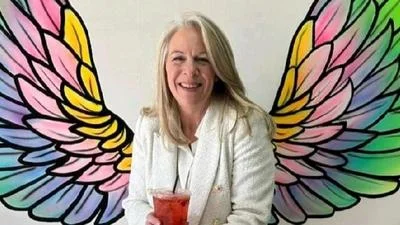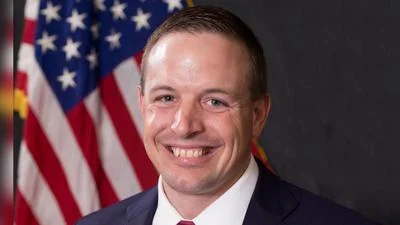Froedtert West Bend Hospital issued the following announcement on October 8.
An abrupt swerve to avoid colliding with another car on the racetrack left Barry in a devastating crash. His injuries required the care and expertise of Wisconsin's only adult Level I Trauma Center.
“You can’t keep a good man down.” That old saw springs straight to mind when speaking with Barry Blackmore, who lives near Los Angeles. The 79-year-old British-born Angeleno seems up for anything, even after a crash that dramatically changed his life.
An avid race car driver for over 60 years, Barry was a regular at Road America in Elkhart Lake. “It’s one of my favorite racetracks in the country, almost like a country club. Sometimes, we had 50,000 spectators.” In July 2020, eager to rock the road in his vintage single-seater Formula 5000 car, Barry headed east with his No. 1 fan, his wife, Karen Blalack.
Before the big event, Barry hit the track for a practice session. It was a damp, overcast morning. “I wasn’t going full speed, maybe 100 or 125, making sure the car was working properly and getting to know the road again.” Coming down a straightaway, he tried to pass a driver who was moving more slowly ahead of him.
“He obviously wasn’t looking in his mirrors when he moved over right in front of me at the very last moment,” Barry said. “I tried to get away from him because I knew if I hit him, it would be a very bad crash for both of us. As it turned out, I put two wheels in the grass, and my car instantly veered off and hit the wall on the side of the track."
“Racing can be dangerous, and hitting a concrete wall with a 1960s aluminum race car is not the thing to do,” he said, laughing. The impact of that collision proved devastating, leaving Barry with a ruptured eye and multiple fractures to his face, spine and legs. He ultimately lost his left eye, and his right leg had to be amputated below the knee.
Teamwork for Speedy Treatment
It took more than 30 minutes to extract Barry from the wreckage of his race car and, because the skies were too cloudy for helicopter transport, another hour to transport him by ambulance to the Froedtert & the Medical College of Wisconsin adult Level I Trauma Center at Froedtert Hospital. When Barry arrived, Marc de Moya, MD, trauma surgeon and Medical College of Wisconsin faculty member, and the trauma team conducted their primary survey, checking Barry’s heart and lungs and assessing his blood loss and injuries. Once he was stabilized, a full complement of medical specialists — including a neurosurgeon, orthopaedic surgeon and eye surgeon — converged to initiate immediate treatment.
Barry Blackmore, pre-crash with his Formula 5000 car
“A CT scan showed us there was bleeding around the brain,” said Nathan Zwagerman, MD, neurosurgeon, MCW faculty member and Director, Pituitary and Skull Base Surgery. “Bleeding can irritate the surface of the brain and cause seizures, so we started Barry on anti-seizure medication. The other problem with a brain injury is swelling. And just like when you roll your ankle, that swelling may not peak for a few days.”
Two days later, Dr. Zwagerman introduced a catheter to drain the fluid around the brain and decrease pressure in Barry’s head. “I worry about swelling and pressure in these situations, but Barry did fairly well and recovered nicely,” Dr. Zwagerman said.
John Rhee, MD, facial plastic and reconstructive surgeon, MCW faculty member and chair, Department of Otolaryngology and Communications Sciences, attended to Barry’s facial injuries, which included a broken maxilla, the upper jaw bone. It had been pushed back into his face, disrupting dental occlusion so his upper and lower teeth didn’t line up.
This is usually corrected by putting wires around individual teeth and attaching them to stabilizing bars to restore alignment. Barry’s bridgework made this a challenge, and Dr. Rhee employed a relatively new device called the MatrixWAVE™ MMF system. Undulating metal plates are placed above and below the teeth and fastened to the maxilla with screws. “Then, we fix the bony fractures in the face itself. Once the bones heal in position and the teeth are well aligned — about four weeks later — we take off those bars,” Dr. Rhee said.
Teamwork is essential in the Trauma Center, especially when treating patients with multiple injuries. For Dr. Rhee, teamwork meant coordinating closely with Deborah M. Costakos, MD, ophthalmologist, MCW faculty member and chair of the MCW Department of Ophthalmology and Visual Sciences. Dr. Costakos operated on Barry’s ruptured eye. “It was very important that I did not manipulate bones around the eye when repairing the facial fractures, because that could have exacerbated the eye injuries. Communication with Dr. Costakos was critical,” Dr. Rhee said.
Although the likelihood of saving Barry’s vision in that eye was slim, Dr. Costakos immediately closed the wound to preclude the possibility of sympathetic ophthalmia, a condition in which the body’s immune system not only attacks the injured eye but also the healthy one, which can lead to more vision loss. “Saving vision in a ruptured globe is not the norm, but we repair these injuries to avoid the sympathetic response,” Dr. Costakos said.
Arguably, the most life-changing result of Barry’s crash was the removal of his right leg below the knee. “On the evening of his arrival at the Trauma Center,” said Greg Schmeling, MD, orthopaedic trauma surgeon and MCW faculty member, “Mr. Blackmore was taken to the operating room, where his wounds were washed and he was outfitted with an external fixator, a framework from which pins are screwed into the tibia to hold bone in place.”
After several days, doctors determined they could not save Barry’s leg due to the extent of his injures. The best option was to amputate.
Turning the Corner in Recovery
In spite of his injuries, Barry made remarkable progress. “He spent 11 days in the Surgical Intensive Care Unit, which is much less time than our team expected given his injuries and age. We were all amazed,” said Thomas Carver, MD, the trauma surgeon and MCW faculty member who managed Mr. Blackmore’s care while he was in the SICU. “If Barry had not been brought to a Level I Trauma Center, it is unlikely he would have seen this outcome.”
“Medicine right now is so specialized that sometimes, it is hard to have a holistic view of the patient. But in a Level I trauma service, all players know the patient’s overall status, and there is great coordination between all the teams,” Dr. Rhee said.
“From the moment I got to the hospital, the people were unbelievable,” Karen said. “They kept me filled in on everything. Everyone was so kind and thoughtful, not only about Barry, but about how I was doing. He healed unbelievably quickly, and I think that’s because of all the support. They were always there for him.”
Back in California, Barry’s get-on-with-it attitude sustains him. He is keeping up with physical therapy and managing well with his prosthesis. “I walked over a mile without any assistance a month or so ago, which I was very proud of,” he said. “I’ve got one eye, but it’s working pretty good. It’s just a matter of getting used to everything.”
Between sailing off to San Diego and taking a trip to France, among other things, it seems Barry is back in the driver’s seat.
Original source can be found here.



 Alerts Sign-up
Alerts Sign-up